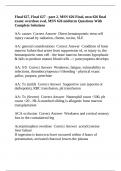Final 627, Final 627 - part 2, MSN 626 Final, msn 626 final
exam: overdose eval, MSN 626 midterm Questions With
Complete Solutions
AA: causes Correct Answer Direct hematopoietic stem cell
injury caused by radiation, chemo, toxins, SLE
AA: general considerations Correct Answer Condition of bone
marrow failure that arises from suppression of, or injury to, the
hematopoietic stem cell - the bone marrow becomes hypoplastic
& fails to produce mature blood cells --> pancytopenia develops
AA: S/S Correct Answer Weakness, fatigue, vulnerability to
infections, thrombocytopenia r/i bleeding - physical exam:
pallor, purpura, petechiae
AA: Tx (mild) Correct Answer Supportive care (epoetin or
darbepotin), RBC transfusion, plt transfusion
AA: Tx (Severe) Correct Answer Neutrophil count <500, plt
count <20 - HLA-matched sibling is allogenic bone marrow
transplantation
ACA occlusion Correct Answer Weakness and cortical sensory
loss in the contralateral leg
Acetaminophen overdose Correct Answer acetylcysteine
liver failure
If ingestion is known to have occurred within 4 hours of
presentation, activated charcoal lowers the plasma
,acetaminophen level more effectively than does gastric lavage or
ipecac, and is typically given as a single dose (1 g/kg).
Acetaminophen overdose: clinical findings Correct Answer Pts
may have n/v but there no other signs of toxicity until 24-48h
after ingestion when hepatic aminotransferase levels begin to
increase
Acetaminophen overdose: diagnosis Correct Answer acute
overdose is based on measurement of the serum acetaminophen
level
Acetaminophen overdose: fulminant hepatic necrosis Correct
Answer Jaundice, hepatic encephalopathy, AKI, death - acute
coma, seizures, HOTN, metabolic acidosis
Acetaminophen overdose: Treatment Correct Answer
Emergency: activated charcoal if given w/in 1-2h after ingestion
- specific tx: If levels fall above the line on the nonogram, tx w/
N-acetylcysteine PO (140mg/kg then 70mg/kg q4h) or IV
- IV: 21h IV acetylcysteine w/ a loading dose of 150mg/kg over
60min - followed by a 4h infusion of 50mg/kg and 12h infusion
of 100mg/kg
- most effective if given if stated w/in 8-10h
Acute idiopathic polyneuropathy: Gullian-Barre syndrome
Correct Answer Acute or subacute - polyradiculoneuropathy
following infective illness, inoculations or surgical procedures -
alcohol intoxication Correct Answer Emotional lability, slurred
speech, ataxia, coma, blackouts. Serum γ-glutamyltransferase
,(GGT)—sensitive indicator of alcohol use. AST value is twice
ALT value
Sx: All alcohols present similarly-ataxia, dysarthria,
somnolence, respiratory depression, odor on breath Dx: Elevated
osmolal gap, elevated anion gap (methanol, ethylene glycol),
serum levels Tx: Fomepizole
Allergic dermatitis Correct Answer Intense pruritus, tiny
vesicles, and weepy and crusted lesions - may occur beyond the
contact area - may be edematous and warm - the location will
often suggest the cause - pattern of eruption may be dx (typical
linear streaked vesicles on the extremities by poison oak or ivy
dermatitis)
Allergic dermatitis: Tx (mild) Correct Answer Severe or
widespread involvement needs systemic corticosteroids, gentle
cleaning and dry compress, calamine lotion & zinc oxide paste -
high dose fluocinonide, Clobetasol) may help relieve itching -
Allergic dermatitis: Tx (Severe) Correct Answer Prednisone
60mg for 4-7d, 40mg for 4-7d and 20mg for 4-7d
AML: S/s Correct Answer Bleeding (thrombocytopenia), Infx
(cellulitis, PNA), gum hypertrophy, bone & joint pain,
hyperleukocytosis - pt may appear pale, purpura, petechiae,
stomatitis, gum hypertrophy,
AML: Tx Correct Answer Combination of an anthracycline
(daunorubicin or idarubicin) plus cytarabine - pts have a poor
prognosis >60y, if reoccurrence, then poor prognosis
, Amoxicillin Correct Answer treat susceptible bacterial
infections of the ear, nose, throat, genitourinary tract, skin, skin
structure, H. pylori, and lower respiratory tract
- 250-500mg q8h
Anaphylaxis: S/S Correct Answer Urticaria, flushing, rashes,
resp distress, wheezing, stridor, bronchospasm, airway
angioedema, HOTN
Anaphylaxis: Tx Correct Answer IM epi - supportive methods
+antihistamines, + bronchodilators, + corticosteroids
Anticholinergic syndrome Correct Answer Tachycardia w/
mild HTN, hyperthermia, pupils are widely dilated - flushed
skin, hot, dry, decreased peristalsis, urinary retention - Pts w/
myoclonic jerking or choreoathetoid mvmts - agitated delirium
Ex: atropine, scopolamine, anticholinergics, antihistamines,
tricyclic antidepressants
AOM: general considerations Correct Answer Bacterial infx of
the middle ear, usually precipitated by a viral URI that causes
eustachian tube obstruction
AOM: recurrent tx Correct Answer Single daily dose of
sulfamethoxazole (500mg) or amoxicillin (250 or 500mg) given
over 1-3m - fx of this tx results in insertion of ventilating tubes
AOM: recurring/resistant infx Correct Answer Complete
tympanocentesis for bacterial of fungal cx




